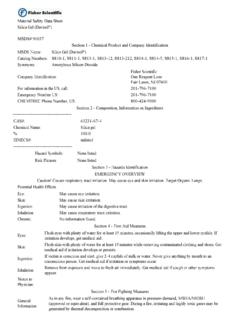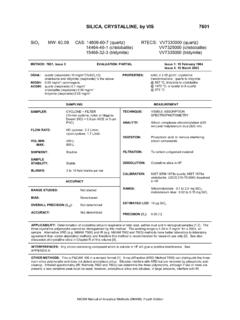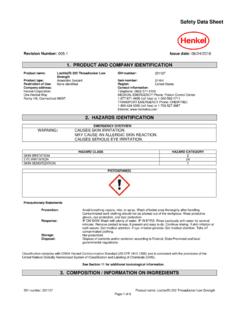Transcription of The Effect of Temperature and pH on the Formation of ...
1 PROCEEDINGS, Thirty-Ninth Workshop on Geothermal Reservoir Engineering Stanford University, Stanford, California, February 24-26, 2014. SGP-TR-202. The Effect of Temperature and pH on the Formation of silica Scaling of Dieng Geothermal Field, Central Java, Indonesia. Winahyu Setyo UTAMI1, Niniek Rina HERDIANITA1,2, Randy Wijaya ATMAJA3. 1. Graduate Program of Geothermal Technology, Faculty of Petroleum and Mining Engineering, Institut Teknologi Bandung 2. Undergraduate Program of Geological Engineering, Faculty of Earth Science and Technology, Institut Teknologi Bandung Jl. Ganesha No. 10, Bandung 40132, West Java, Indonesia 3. PT Geo Dipa Energi, Recapital Building 8th Floor Jl. Aditiawarman Kav. 55, South Jakarta 12160, Indonesia Keywords: silica scaling, Temperature , deposition rate, pH, Dieng. ABSTRACT. Dieng Geothermal Field has been long encountered with a severe production issue regarding to silica scaling, in which has also been a serious problem in many other water-dominated hydrothermal fields.
2 This paper examines silica scaling occurence in the surface facilities of Dieng Geothermal Field, separator, brine pipeline, and weirbox, and thus most likely has affected adversely to the production activities of the field. Accordingly, the deposition of silica is highly dependent on Temperature and pH of fluid. In which, the estimation of silica deposition at two representative production wells, Well A and Well B, was obtained by sampling of separator water and calculating the SiO2. concentration within the brine. The value of silica deposition was obtained by calculating the difference between the value of dissolved SiO2 with the solubility of amorphous silica curve in respect of the Temperature and pH. The result of this research shows that the process of silica scaling Formation at the surface facilities of Dieng Geothermal Field is controlled by Temperature and pressure and pH solution change. The solubility of amorphous silica increases significantly at pH > 7 in both of separators in Well A and Well B, and pH > 8 in both weirboxes.
3 1. INTRODUCTION. Dieng Geothermal Field is located in Dieng Volcanic Complex, 26 kilometers north of Wonosobo, Central Java and northwest of Sindoro Volcano and Sumbing Volcano complex (see Figure 1). The field is situated within the volcanic highlands of Dieng Plateau at elevation of over 2000 meters (Layman et al., 2002). Currently, PT Geo Dipa Energi has managed to produce 60 MWe from Dieng Power Plant Unit-1 out of the total 300 MWe potential. At a water-dominated geothermal system, with a relatively high concentration of dissolved SiO2, silica scaling would potentially be deposited. The Dieng Geothermal Field is a high- Temperature (~300oC) water-dominated geothermal system field having a significantly high silica concentration at the reservoir fluid. silica scaling occurs at the surface facilities of the field, such as separator, brine pipeline, and weirbox, and adversely affects the production activities. The precipitation of silica is strongly dependent on the Temperature and the pH.
4 This paper discusses the effects of Temperature and pH, CO2 concentration within the brine, and which factors that mostly dominates the scaling silica Formation at the surface facilities of Dieng Geothermal Field. Also the deposition rate is calculated regarding to fluid flow rate on each well. In this study, silica scaling Formation is evaluated at two representative production wells of the Dieng Geothermal Field, Well A and Well B. Utami, Herdianita, and Atmaja Figure 1. Location of the Dieng Geothermal Field, Central Java, Indonesia. 2. METHODOLOGY. The calculation of water and gas composition In order to obtain the water composition of Dieng Geothermal Field, water and gas sampling activities were carried out in two representative wells, Well A and Well B. Further, the SiO2 concentration within the brine was taken from the separator. Meanwhile, the gas composition was taken from the separator by PT Geo Dipa Energi. The required water and gas data that will be used in this study are the composition of dissolved SiO2 and CO2 in the water at reservoir, separator, and weirbox.
5 The concentration of dissolved SiO2 and CO2 at reservoir and weirbox were calculated by using the equation of heat and mass balance (Nicholson, 1993). The steam separation at two wells is assumed to occur two times, at separator and at weirbox. Solubility of amorphous silica At the reservoir, the SiO2 content is in a equilibrium state with quartz (Brown, 2011). However, precipitated silica at the surface is normally in an amorphous silica form. The solubility of amorphous silica with Temperature in pure water has been measured (Fournier and Rowe, 1966, op. cit. Brown 2011). The solubility is expressed by, 731. log C 4 . 52. T (Eq. 1). where C is silica concentration in mg/L and T is an absolute Temperature in Kelvin. This approximate equation is valid for 0 250oC. Utami, Herdianita, and Atmaja And the solubility of amorphous silica as a function of pH can be expressed as (Brown, 2011), 10 pH K .. S C 1 . 1.. (Eq. 2).. ( H 3 SiO 4 ).
6 Where C is the same as Eq. 1, K1 is the dissociation constant, which can be obtained with log K1= -2549/T x 10-6T2 (T in Kelvin), and H3 SiO4- that can be calculated from the Debye-H ckel equation and the ionic strength of the solution (Brown, 2011). 3. RESULTS AND ANALYSIS. silica scaling at Well A. (a) (b). Figure 2. The calculated amorphous silica solubility with (a) Temperature (modification of Fournier, 1985 op. cit. Nicholson, 1993) and (b) pHT, at Well A. (I is ionic strength). The water from reservoir ascends to the surface through Well A adiabatically. The fluid is then flashed in the separator at 11 bar or 184oC. In Figure 2a, SiO2 concentration of reservoir is below the amorphous silica saturation curve, in which consequently silica scaling is not formed. However, since the fluid moves rapidly, quartz, cristobalite, and chalcedony are not formed in reservoir. As the fluid reaches separator, the SiO2 concentration will be above the amorphous silica saturation curve, and also would potentially form about 113 mg/L (SSI: ) and returned to the saturation state.
7 The residual water, as the result of steam separation, flows through the brine pipeline from the separator towards weirbox. A significant change of pressure and Temperature occurs and increases the SiO2 content within the water in weirbox. SiO2 concentration at weirbox is also above the amorphous silica saturation curve, and would potentially form about 629 mg/L (SSI: ). In Figure 2b, the SiO2 concentration within the water in separator, with pH , becomes supersaturated in respect of amorphous silica solubility at 184oC. silica scaling will potentially be formed in separator for as much as 94 mg/L. and returned to the saturation state. The residual water flows directly to weirbox through surface pipeline which induces the water to flash at 100oC. The concentration of silica becomes more supersaturated over amorphous silica solubility, and the water pH is increased due to the CO2 release (pH ). Futhermore, silica scaling is potentially formed about 640 mg/L.
8 Utami, Herdianita, and Atmaja silica scaling at Well B. In Figure 3a, SiO2 concentration in Well B is much higher compared to Well A. However, the silica concentration in Well B reservoir is still below the amorphous silica saturation curve, therefore silica scaling will not occur. As the fluid reaches the surface, the fluid will be flashed in the separator at 10 bar atm or 181oC. Further, SiO2 concentration at separator becomes supersaturated in respect of the amorphous silica saturation curve, and silica scaling will be potentially formed for about 666 mg/L (SSI: ) and returned to the state of saturation. (a) (b). Figure 3. The calculated amorphous silica solubility with (a) Temperature (modification of Fournier, 1985 op. cit. Nicholson, 1993) and (b) pHT, at Well B (I is ionic strength). The residual water, as the result of steam separation, flows through the brine pipeline from the separator towards weirbox. A significant change of pressure and Temperature occurs and increases the SiO 2 content within the water in weirbox.
9 SiO2 concentration at weirbox is also above the amorphous silica saturation curve, and silica is potentially precipitated about 601 mg/L (SSI: ). In Figure 3b, the SiO2 concentration within the water in separator, with pH , becomes supersaturated in respect of the amorphous silica solubility at 181oC. silica scaling are potentially formed at separator as much as 657 mg/L and returned to the state of saturation. The residual water flows directly to weirbox through surface pipeline which induces the water to flash at 100oC. The concentration of silica becomes more supersaturated over the amorphous silica solubility, and the water pH rises due to the CO2 release (pH ). silica scaling are potentially formed about 604. mg/L. Deposition rate From the results in Section and , the deposition rate of silica scaling can be estimated. The deposition rate in each well can be seen at Table 1. The deposition rate in Well A and Well B are determined regarding to the mass per time units.
10 From the results earlier can be seen that Well A produces more silica scaling than Well B. The amount of silica scaling that have been produced are mostly affected by the concentration of potential silica deposits within the fluid and the mass flow rate values. The higher the potential deposit of silica , the greater the deposition rate. This calculation was done by assuming that there was no inhibitor liquid has been injected to the brine pipelines. Utami, Herdianita, and Atmaja Table 1. The calculation of deposition rate in Well A and Well B. (*) The mass flow rate data were taken in July 2012 by PT Geo Dipa Enegi. The potential deposit unit mg/L is assumed to be equal with mg/kg to simplify the calculation. Potential Mass Flow Deposition Rate Well Location Deposits Rate*. mg/kg kg/s ton/hour ton/day ton/month ton/year Separator 100 A Weirbox 630 Separator 660 B Weirbox 600 The data of surface pipelines length and diameter are not given, consequently, the thickness of the silica scaling along the pipelines cannot be estimated.














